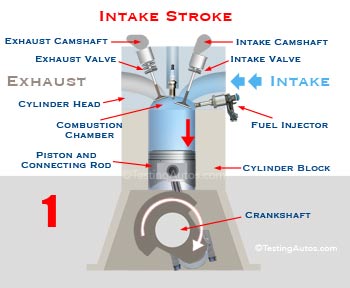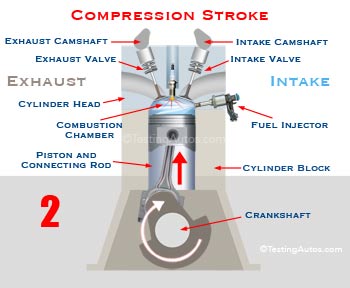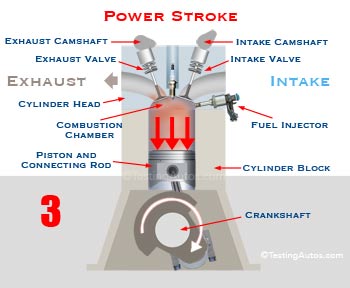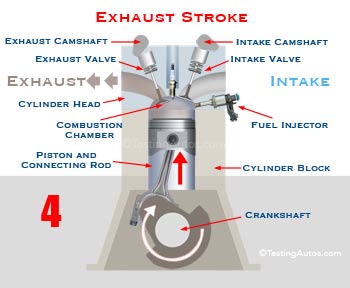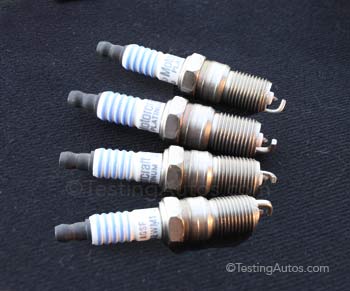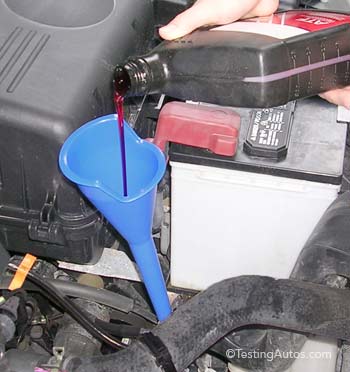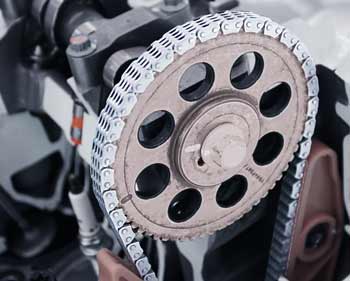Four-Stroke Engine: Animation, Each Stroke Explained
Updated: September 08, 2022
Modern cars have a four-stroke engine. The stroke is the up or down movement of the piston in the cylinder between the top and the bottom positions. One revolution of the crankshaft equals two strokes.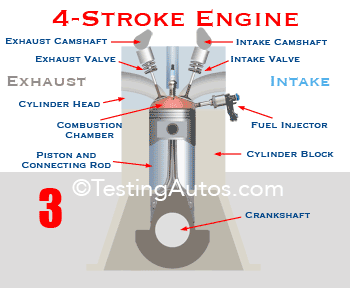 Four-stroke gasoline direct-injected engine animation. See the same animation at a slow speed.
Four-stroke gasoline direct-injected engine animation. See the same animation at a slow speed.In a four-stroke engine, each cylinder "fires" on every second revolution of the crankshaft. The full combustion cycle consists of two revolutions of the crankshaft and four strokes:
1. Intake stroke
2. Compression stroke
3. Power stroke
4. Exhaust stroke.
To illustrate, we created these two animations of a four-stroke direct-injected gasoline and diesel engines. We chose a direct-injected engine because more than half of new cars with a gasoline engine have a direct injection. See the four-stroke diesel engine animation below.
The gasoline direct injection is different from a conventional fuel injection in the location of the injector: In a conventional port fuel injection, the injector is installed in the intake port, above the intake valve. In a gasoline direct-injected engine, the injector nozzle protrudes into the combustion chamber. The fuel is sprayed under very high pressure directly into the combustion chamber.
1. Intake Stroke
The engine crankshaft keeps rotating by inertia from the previous power stroke. The intake stroke is always considered the first of the sequence.During the intake stroke, the piston moves down, creating a vacuum above it. The camshaft opens the intake valve(s) drawing the air from the intake manifold. The intake valve starts opening at the end of the exhaust stroke of the previous cycle.
As the piston moves down, the air fills the cylinder. Soon after the piston reaches the bottom position, the intake valve closes. The exhaust valve is closed during the intake stroke.
2. Compression Stroke
During the compression stroke, the intake and exhaust valves are closed. As the piston moves up, it compresses the air trapped in the cylinder.The direct fuel injector injects gasoline under a very high pressure into the cylinder during the compression stroke, when the piston is closer to the top. Just before the piston reaches the top position, the spark between the spark plug electrodes ignites the air/fuel mixture.
The top-most position of the piston is called Top Dead Center or TDC. The combustion happens in the combustion chamber, which is the space between the top of the piston and the cylinder head.
3. Power Stroke
In the power stroke, the pressure of hot gases created during the combustion pushes the piston down with great force. The power stroke provides the energy to turn the wheels in a car.After the power stroke, the crankshaft keeps rotating due to the inertia of the heavy components attached to the crankshaft. In cars with a manual transmission it's the flywheel. In cars with an automatic transmission, it's the torque converter.
During the power stroke, both the intake and exhaust valves are still closed. As the piston approaches the bottom position in the power stroke, the exhaust valve starts opening, allowing hot exhaust gases to rush out. In some literature, the power stroke is called 'expansion stroke' or 'combustion stroke'.
4. Exhaust Stroke
During the exhaust stroke, the exhaust valve is open and the intake valve is closed. The piston moves up pushing the remaining exhaust gases out of the cylinder and into the exhaust manifold.The exhaust stroke is the last stroke of the cycle. As the piston approaches the top position (TDC), the intake valve starts opening for the intake stroke of the next combustion cycle. The exhaust valve closes right after the piston reaches TDC.
How a four-stroke diesel engine works:
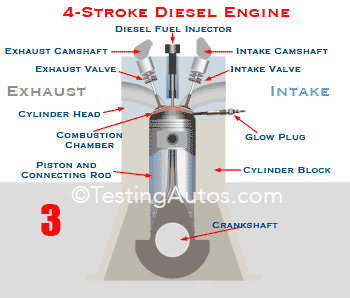 Four-stroke diesel engine animation.
Four-stroke diesel engine animation.For this reason, a diesel engine has a higher compression ratio achieved by reducing the size of the combustion chamber. The diesel fuel injector injects the fuel under very high pressure at the end of the compression stroke.
When the engine is cold, an electric glow plug heats up, helping ignite the diesel fuel. In a diesel engine, the piston and other components are made beefier to withstand a higher compression ratio.
